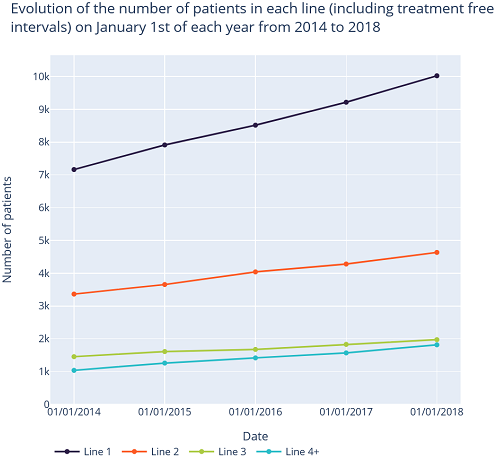
Contributions
Abstract: EP999
Type: E-Poster Presentation
Session title: Myeloma and other monoclonal gammopathies - Clinical
Background
Multiple myeloma (MM) is considered as an incurable hematologic disease. Net cancer-specific survival at 5 years after diagnosis of MM was estimated at 47% between 2005 and 2010. Thanks to significant improvements of the MM therapeutic management in the past decades, the overall survival of MM patients tends to increase, and some patients now achieve long-term remission. This directly impacts the dynamic of MM epidemiology. The world age-standardized MM incidence rate in France was estimated at 4.1/100 000/year in 2020, based on extrapolations from available regional data. For the first time, this study provides updated and comprehensive epidemiological data by line of treatments based on the nationwide French National Health Insurance (NHI) databases, called SNDS (“Système National des Données de Santé”). These databases include hospital records, primary and secondary care for 66 million people.
Aims
To estimate incidence, prevalence of multiple myeloma and mortality of these patients, each year and for each line from 2014 to 2018, based on secondary use of data from the French NHI databases.
Methods
This is a retrospective observational cohort study of multiple myeloma patients identified through the French NHI databases, SNDS from 2014 to 2018. To identify patients with MM, a published algorithm was used as a base and was expanded to consider recent evolutions of MM therapeutic management. The rates were standardized using the age distribution in the world population. Treatment lines were re-constructed through ATLAS, a published adaptation of the Smith-Waterman alignment sequence algorithm, by scanning day-by-day patient claims.
Results
56,247 prevalent MM patients were identified from 2014 to 2018. Among them, 36,208 patients (64.4%) were treated for MM. The world age-standardized prevalence rates tend to regularly increase every year (from 19.6/100,000/year in 2014 to 23.6 in 2017, 2018 to be consolidated). In 2017, the 23,496 prevalent patients presented a median age of 70 years old. In average, they started their first treatment for MM 3.2 years (+/- 2.9) ago. The standardized incidence rate tends to increase over the years from 2014 to 2017. In 2017 the incidence rate was 4.7 (4.5-4.8)/100 000 person-years and was slightly higher among men (5.4 (5.2-5.6)) than women (4.0 (3.8-4.2)), and much higher in patients ≥ 65 years old (31.7 (30.6-32.9)). Standardized mortality rate was estimated at 3.2 (2.5-3.9) in 2017, respectively 3.6 (2.5-4.6) in men and 2.8 (1.9-3.6) in women, with a tendency to decrease slowly over the years. Moreover, as displayed on the figure attached, the number of treated patients for each line tends to increase overtime going for instance from 7,163 in 2014 to 10,022 in 2018 for patients in L1. The number of patients receiving a L4+ increased between 2014 (N=1040) and 2018 (N=1818).

Conclusion
This study expands existing epidemiological data on MM patients in France and is the first to present recent nationwide results by line of treatment. Incidence rates are in accordance with the estimations from French network of cancer registries confirming that the French health insurance databases are a valuable source of data to further study the therapeutic management of multiple myeloma.
Keyword(s): Epidemiology, Incidence, Multiple myeloma, Prevalence
Abstract: EP999
Type: E-Poster Presentation
Session title: Myeloma and other monoclonal gammopathies - Clinical
Background
Multiple myeloma (MM) is considered as an incurable hematologic disease. Net cancer-specific survival at 5 years after diagnosis of MM was estimated at 47% between 2005 and 2010. Thanks to significant improvements of the MM therapeutic management in the past decades, the overall survival of MM patients tends to increase, and some patients now achieve long-term remission. This directly impacts the dynamic of MM epidemiology. The world age-standardized MM incidence rate in France was estimated at 4.1/100 000/year in 2020, based on extrapolations from available regional data. For the first time, this study provides updated and comprehensive epidemiological data by line of treatments based on the nationwide French National Health Insurance (NHI) databases, called SNDS (“Système National des Données de Santé”). These databases include hospital records, primary and secondary care for 66 million people.
Aims
To estimate incidence, prevalence of multiple myeloma and mortality of these patients, each year and for each line from 2014 to 2018, based on secondary use of data from the French NHI databases.
Methods
This is a retrospective observational cohort study of multiple myeloma patients identified through the French NHI databases, SNDS from 2014 to 2018. To identify patients with MM, a published algorithm was used as a base and was expanded to consider recent evolutions of MM therapeutic management. The rates were standardized using the age distribution in the world population. Treatment lines were re-constructed through ATLAS, a published adaptation of the Smith-Waterman alignment sequence algorithm, by scanning day-by-day patient claims.
Results
56,247 prevalent MM patients were identified from 2014 to 2018. Among them, 36,208 patients (64.4%) were treated for MM. The world age-standardized prevalence rates tend to regularly increase every year (from 19.6/100,000/year in 2014 to 23.6 in 2017, 2018 to be consolidated). In 2017, the 23,496 prevalent patients presented a median age of 70 years old. In average, they started their first treatment for MM 3.2 years (+/- 2.9) ago. The standardized incidence rate tends to increase over the years from 2014 to 2017. In 2017 the incidence rate was 4.7 (4.5-4.8)/100 000 person-years and was slightly higher among men (5.4 (5.2-5.6)) than women (4.0 (3.8-4.2)), and much higher in patients ≥ 65 years old (31.7 (30.6-32.9)). Standardized mortality rate was estimated at 3.2 (2.5-3.9) in 2017, respectively 3.6 (2.5-4.6) in men and 2.8 (1.9-3.6) in women, with a tendency to decrease slowly over the years. Moreover, as displayed on the figure attached, the number of treated patients for each line tends to increase overtime going for instance from 7,163 in 2014 to 10,022 in 2018 for patients in L1. The number of patients receiving a L4+ increased between 2014 (N=1040) and 2018 (N=1818).

Conclusion
This study expands existing epidemiological data on MM patients in France and is the first to present recent nationwide results by line of treatment. Incidence rates are in accordance with the estimations from French network of cancer registries confirming that the French health insurance databases are a valuable source of data to further study the therapeutic management of multiple myeloma.
Keyword(s): Epidemiology, Incidence, Multiple myeloma, Prevalence


